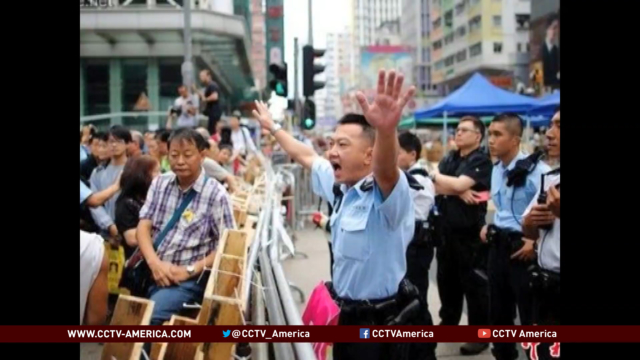Hong Kong’s High Court is once again trying to clear the city’s streets of demonstrators extending an injunction that bans protesters from occupying parts of Mong Kok. But is it having any impact? CCTV America’s Han Peng reports from Hong Kong.

In what the Hong Kong Journalists Association calls a “barbaric and unacceptable” attack, four journalists were assaulted by a group of anti-Occupy Central protesters in the middle of their coverage. The public is outraged, saying that this is not just about the personal safety of individual reporters, but is a blunt violation of the freedom of press.
While violence against the press must be condemned, some anti-Occupy Central protesters also expressed to us their resentment over what they believe to be unfair and biased coverage by some Hong Kong media.
“In many cases, it’s the media that seems to be on the frontline of inciting the illegal occupation,” said Yip Wingcing, anti-occupy central protester. “Some media have already taken side before their coverage. They are not speaking the truth of public opinion.”
An amateur video, which CCTV cannot independently verify, appears to show a journalist with Cable TV, one of the most influential media in Hong Kong, engaged in selling pro-Occupy Central souvenirs at a major gathering site.
Even if there is biased reporting, police say it doesn’t justify the violence against individuals. They pledge to handle the assault on journalists in accordance to the law.
The Hong Kong Journalists Association says a total of 24 journalists have been assaulted since the Occupy Central protest started.
There is also a media report about a Mainland journalist being physically threatened during her interview. The reporter, working with China News Agency, found herself surrounded by a group of Occupy Central protesters as she was covering their occupation. The protesters forced her to delete all the footage she had obtained legally in her camera. Besides violence against reporters, protesters themselves are also seen on the street engaging in fierce arguments and, sometimes, physical violence between the two camps.
In Mong Kok, a group of peaceful pro-government residents showed up in front of the Occupy Central protesters, holding large national flags of China. They were immediately surrounded by the angry protesters, who tried to take down the flags. In the ensuing scuffles, the flags fell underfoot.
Some say that this has gone too far. In China, disrespect for the national flag is widely seen as a sign of denying one’s identify as a Chinese citizen.
 CGTN America
CGTN America
